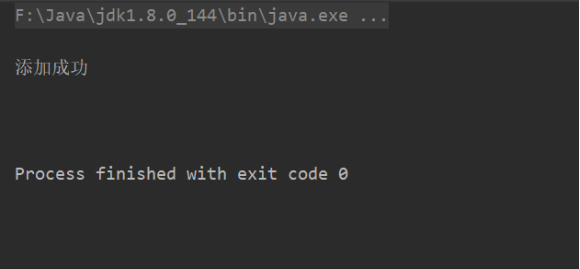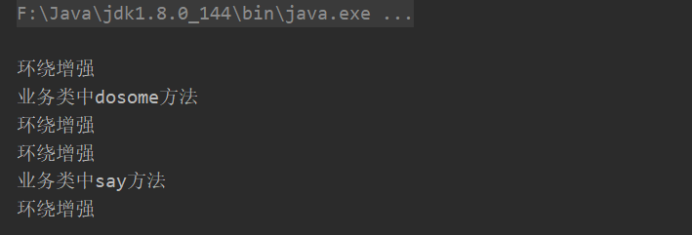使用注解方式实现 AOP和IoC
使用注解方式实现AOP和IoC
IOC和DI的注解
IOC:
@Component:实现Bean组件的定义
@Repository:用于标注DAO类,功能与@Component作用相当
@Service:用于标注业务类
@Controller:用于标注控制器
DI:
@Resource(name="userService")
默认ByName方式,如果name确实默认按照ByType方式注入
@Autowired
默认ByType方式,如果出现同名类,则不能按照Type进行注入
需要使用@Qualifier 指明ID
1. 使用注解实现IoC案例
1.1 编写applicationContext.xm文件
<!--扫描注解:包扫描器--> <context:component-scan base-package="cn.spring"/>
1.2创建mapper接口
public interface UserMapper {
public int addUser(User user);
}
1.3 创建mapper接口实现类
@Repository
public class UserMapperImpl implements UserMapper {
@Override
public int addUser(User user) {
System.out.println("添加成功");
return 1;
}
}
1.4创建Service接口
public interface UserService {
public int addUser(User user);
}
1.5创建Service接口实现类
@Service("userServiceImpl")
public class UserServiceImpl implements UserService {
//植入Dao层对象
//@Resource默认是根据byName的方式,但是一旦名字为空 ,就根据byType
@Autowired
private UserMapper userMapper;
@Override
public int addUser(User user) {
return userMapper.addUser(user);
}
}
1.6 编写测试类
@org.junit.Test
public void test2() {
ApplicationContext context = new ClassPathXmlApplicationContext("applicationContext.xml");
//通过类型调度
//UserInfoService userService=context.getBean(UserService.class);
//指定@Service的value值后使用bean的id名称调度
UserService userServiceImpl = (UserService) context.getBean("userServiceImpl");
userServiceImpl.addUser(new User());
}
1.7 控制台

使用注解方式实现AOP
- 实现AOP的注解有
- @Aspect 声明切面
- @Ponitcut 声明公共的切点表达式
- @Before 前置增强
- @AfterReturning 后置增强
- @Around 环绕增强
- @AfterThrowing 异常抛出增强
- @After 最终增强
1.使用注解方式实现前置增强和后置增强
1.1 编写applicationContext.xml文件
<!--开启AOP注解支持--> <aop:aspectj-autoproxy/>
1.2 创建Service类
@Service("IDoSomeService")
public class IDoSomeService {
public void doSome(){
System.out.println("业务类中dosome方法");
}
public void say(){
System.out.println("业务类中say方法");
}
}
1.3 编写切面类实现增强
@Aspect
@Component
public class MyAdvice {
@Pointcut("execution(* *..service.*.*(..))")
public void point(){
}
@Before("point()")
public void before(){
System.out.println("前置增强");
}
@AfterReturning("execution(* *..service.*.*(..))")
public void afterReturning(){
System.out.println("后置增强");
}
}
1.4 编写测试类
@org.junit.Test
public void test3(){
ApplicationContext context=new ClassPathXmlApplicationContext("applicationContext.xml");
IDoSomeService iDoSomeService = (IDoSomeService)context.getBean("IDoSomeService");
iDoSomeService.doSome();
iDoSomeService.say();
}
1.5 控制台

2. 使用注解方式实现环绕增强
2.1 编写applicationContext.xml文件
<!--扫描注解:包扫描器--> <context:component-scan base-package="cn.spring"/> <!--开启AOP注解支持--> <aop:aspectj-autoproxy/>
2.2 创建Service类
@Service("IDoSomeService")
public class IDoSomeService {
public void doSome(){
System.out.println("业务类中dosome方法");
}
public void say(){
System.out.println("业务类中say方法");
}
}
2.3编写切面类实现增强
@Aspect
@Component
public class AroundAdvisor {
@Around("execution(* *..service.*.*(..))")
public void around(ProceedingJoinPoint PJ) throws Throwable {
System.out.println("环绕增强");
PJ.proceed();
System.out.println("环绕增强");
}
}
2.4编写测试类
@org.junit.Test
public void test3(){
ApplicationContext context=new ClassPathXmlApplicationContext("applicationContext.xml");
IDoSomeService iDoSomeService = (IDoSomeService)context.getBean("IDoSomeService");
iDoSomeService.doSome();
iDoSomeService.say();
}
2.5控制台

3. 使用注解实现异常抛出增强
在exception包下完成对应的用例。
声明切面类
@Aspect
public class AroundLoggerAnno {
@Around("execution(* com.cmy.service.*.*(..))")
public Object aroundLogger(ProceedingJoinPoint jp) throws Throwable {
System.out.println("调用 " + jp.getTarget() + " 的 " + jp.getSignature().getName()
+ " 方法。方法入参:" + Arrays.toString(jp.getArgs()));
try {
Object result = jp.proceed();
System.out.println("调用 " + jp.getTarget() + " 的 "
+ jp.getSignature().getName() + " 方法。方法返回值:" + result);
return result;
} catch (Throwable e) {
System.out.println(jp.getSignature().getName() + " 方法发生异常:" + e);
throw e;
} finally {
System.out.println(jp.getSignature().getName() + " 方法结束执行。");
}
}
创建Spring的核心配置文件,开启Spring对IOC和AOP注解的支持
新增app-08.xml文件
<!--开启Spring IOC的注解支持 base-package 包扫描语句 com.cmy包下的注解--> <context:component-scan base-package="com.cmy"/> <!--配置增强类 交给Spring容器管理--> <bean class="com.cmy.exception.ErrorLogger"></bean> <!--开启Spring AOP注解的支持--> <aop:aspectj-autoproxy />
编写测试用例,在DoSomeServiceImpl模拟异常
public class Demo2 {
public static void main(String[] args) {
//声明式增强 必须加载Spring容器
ApplicationContext app = new ClassPathXmlApplicationContext("com/cmy/exception/app-08.xml");
//获取代理对象
DoSomeService doSomeService=(DoSomeService)app.getBean("doSomeService");
doSomeService.say();
}
}
4.使用注解实现最终增强
使用After包,增加切面类
/**
* 通过注解实现最终增强
*/
@Aspect
public class AfterLoggerAnno {
@After("execution(* com.cmy.service.*.*(..))")
public void afterLogger(JoinPoint jp) {
System.out.println(jp.getSignature().getName() + " 方法结束执行。");
}
}
新建app-10.xml文件
<!--开启Spring IOC的注解支持 base-package 包扫描语句 com.cmy包下的注解--> <context:component-scan base-package="com.cmy"></context:component-scan> <!--配置增强类 交给Spring容器管理--> <bean class="com.cmy.after.AfterLoggerAnno"></bean> <!--开启Spring AOP注解的支持--> <aop:aspectj-autoproxy />
创建测试用例
public class Demo2 {
public static void main(String[] args) {
//声明式增强 必须加载Spring容器
ApplicationContext app = new ClassPathXmlApplicationContext("com/cmy/after/app-10.xml");
//获取代理对象
DoSomeService doSomeService=(DoSomeService)app.getBean("doSomeService");
doSomeService.say();
}
}
使用注解方式实现 AOP和IoC的更多相关文章
- (转)使用Spring的注解方式实现AOP入门
http://blog.csdn.net/yerenyuan_pku/article/details/52865330 首先在Eclipse中新建一个普通的Java Project,名称为spring ...
- 基于AspectJ的注解方式进行AOP开发
-------------------siwuxie095 基于 AspectJ 的注解方式进行 AOP 开发 ...
- (转)使用Spring的注解方式实现AOP的细节
http://blog.csdn.net/yerenyuan_pku/article/details/52879669 前面我们已经入门使用Spring的注解方式实现AOP了,现在我们再来学习使用Sp ...
- Spring系列之aAOP AOP是什么?+xml方式实现aop+注解方式实现aop
Spring系列之aop aop是什么?+xml方式实现aop+注解方式实现aop 什么是AOP? AOP为Aspect Oriented Programming 的缩写,意识为面向切面的编程,是通过 ...
- spring----IOC注解方式以及AOP
技术分析之Spring框架的IOC功能之注解的方式 Spring框架的IOC之注解方式的快速入门 1. 步骤一:导入注解开发所有需要的jar包 * 引入IOC容器必须的6个jar包 * 多引入一个:S ...
- Spring的注解方式实现AOP
Spring对AOP的实现提供了很好的支持.下面我们就使用Spring的注解来完成AOP做一个例子. 首先,为了使用Spring的AOP注解功能,必须导入如下几个包.aspectjrt.jar,asp ...
- 使用Spring的注解方式实现AOP
Spring对AOP的实现提供了很好的支持.下面我们就使用Spring的注解来完成AOP做一个例子. 首先,为了使用Spring的AOP注解功能,必须导入如下几个包.aspectjrt.jar,asp ...
- spring 纯注解方式 与AOP
spring注解方式 以前我也使用过纯注解方式.现在在这里做个记录 我们先认识几个我们都耳熟能详的注解 @configuration :从spring3.0这个注解就可以用于定义配置类,可以替换xml ...
- 注解方式实现AOP编程
步骤: 1) 先引入aop相关jar文件 (aspectj aop优秀组件) spring-aop-3.2.5.RELEASE.jar [spring3.2源码] aopal ...
随机推荐
- springmvc 拦截器与用户验证token
1:springmvc 配置文件中添加拦截器,当然首先要有拦截后交给哪个类处理也要写上 <mvc:interceptors> <mvc:interceptor> <mvc ...
- (二)spring初次遇见shiro
文章目录 集成 Spring 集成中的坑 shiroFilter 的工作原理 权限配置细节 集成 Spring pom.xml 添加shiro相关的依赖 我使用的版本是 ${version.shiro ...
- google test 打印派生类对象
在Unison中使用google test时,发现EXPECT_EQ在fail时,不能打印Unison Test Language中定义的派生类的对象.于是写了个纯C++的示例,发现在只定义基类的op ...
- CSS样式三种形式
CSS基本表现形式只有三种:标签样式.Class类样式.ID样式 标签样式: 必须与HTML标签同名.仅仅影响同名标签 Class样式:可以在任何标签中使用: class="样式名" ...
- 解决VS2017中使用scanf函数报错的问题
我们在VS2017中如果使用C语言的scanf输入函数,编译的时候编译器会报error C4996: 'scanf': This function or variable may be unsafe. ...
- PAT(B) 1087 有多少不同的值(Java)规律
题目链接:1087 有多少不同的值 (20 point(s)) 题目描述 当自然数 n 依次取 1.2.3.--.N 时,算式 ⌊n/2⌋+⌊n/3⌋+⌊n/5⌋ 有多少个不同的值?(注:⌊x⌋ 为取 ...
- 第二次用map23333
度熊所居住的 D 国,是一个完全尊重人权的国度.以至于这个国家的所有人命名自己的名字都非常奇怪.一个人的名字由若干个字符组成,同样的,这些字符的全排列的结果中的每一个字符串,也都是这个人的名字.例如, ...
- JDK8源码解析 -- HashMap(一)
最近一直在忙于项目开发的事情,没有时间去学习一些新知识,但用忙里偷闲的时间把jdk8的hashMap源码看完了,也做了详细的笔记,我会把一些重要知识点分享给大家.大家都知道,HashMap类型也是面试 ...
- werkzeug/routing.py-Rule源码分析
Rule类主要用来定义和表示一个URL的模式.主要定义了一些关键字参数,用来改变url的行为.例如:这个url可以接收的请求方法,url的子域名,默认路径,端点名称,是否强制有斜杠在末尾等等 在最开始 ...
- 解决 VUE项目过大nodejs内存溢出问题
今天在启动vue项目的时候报了这样一个错误, 如图所示:频繁出现此种情况,项目太大,导致内存溢出,排除代码问题外,可参照以下方式解决 // 全局安装increase-memory-limit npm ...
